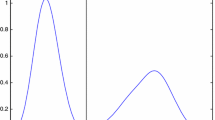Abstract
This paper investigates whether codependence restrictions can be uniquely imposed on VAR models via the so-called pseudo-structural form used in the literature. Codependence of order q is given if a linear combination of autocorrelated variables eliminates the serial correlation after q lags. Importantly, maximum likelihood estimation and likelihood ratio testing are only possible if the codependence restrictions can be uniquely imposed. Applying the pseudo-structural form, our study reveals that this is not generally the case, but that unique imposition is guaranteed in several important special cases.
Similar content being viewed by others
References
Cubadda, G., Hecq, A.: On non-contemporaneous short-run comovements. Econ. Lett. 73, 389–397 (2001)
Engle, R.F., Kozicki, S.: Testing for common features. J. Bus. Econ. Stat. 11, 369–380 (1993)
Franchi, M., Paruolo, P.: A characterization of vector autoregressive processes with common cyclical features. J. Econom. 163, 105–117 (2011)
Gourieroux, C., Peaucelle, I.: (1988) Detecting a long-run relationship (with an application to the P.P.P. hypothesis). Working Paper 8902, CREMAP
Gourieroux, C., Peaucelle, I.: Series codependantes: application a l’hypothese de parité du pouvoir d’achat. Rev. d’Analyse Economique 68, 283–304 (1992)
Lütkepohl, H.: New Introduction to Multiple Time Series Analysis. Springer, Berlin (2005)
Paruolo, P.: (2003) Common dynamics in I(1) VAR systems. Discussion Paper 2003/35. Department of Economics, University of Insubria
Schleicher, C.: Codependence in cointegrated autoregressive models. J. Appl. Econom. 22, 137–159 (2007)
Tiao, G.C., Tsay, R.S.: Model specification in multivariate time series (with discussion). J. R. Stat. Soc. Ser. B 51, 157–213 (1989)
Trenkler, C., Weber, E.: (2012) Codependent VAR models and the pseudo-structural form. Working Paper ECON 12-10. Department of Economics, University of Mannheim
Trenkler, C., Weber, E.: Testing for codependence of non-stationary variables. Appl. Econ. 45, 1953–1964 (2013)
Vahid, F., Engle, R.F.: Common trends and common cycles. J. Appl. Econom. 8, 341–360 (1993)
Vahid, F., Engle, R.F.: Codependent cycles. J. Econom. 80, 199–221 (1997)
Vahid, F., Issler, J.V.: The importance of common cyclical features in VAR analysis: a Monte-Carlo study. J. Econom. 109, 341–363 (2002)
Acknowledgments
We are grateful to two anonymous referees, the editor, Kyusang Yu and participants of seminars at the Central Bank Norway, the Humboldt University Berlin, the Leibniz University Hannover, and the University of Mannheim for very helpful comments. Of course, all remaining errors are our own.
Author information
Authors and Affiliations
Corresponding author
Additional information
The research was supported by the Deutsche Forschungsgemeinschaft (DFG) through the SFB 884 ‘Political Economy of Reforms’.
Appendix: numerical examples
Appendix: numerical examples
Consider a three-dimensional version of the VAR in (1) of order three with
We assume \(a_{31,1} \ne 0\) and \(a_{33,1}\ne 0\). If \(a_{12,3}=-0.16\), then \(\delta _0 = (1 -\!1 \,0)^\prime \) is a codependence vector which generates codependence of order \(q=2\) with respect to \(y_t\). We have \(\gamma _0 = (1 -\!1\;0 \;0 \cdots 0)^\prime \), \(\gamma _1=\gamma _0^\prime \varvec{A} = (0 \; 0.1 \;0 \;0 \; 0.36 \; 0 \; 0 -\!0.16 \; 0)^\prime \), and \(\gamma _2=\gamma _1^\prime \varvec{A}=(0\;0.4\;0\;0 -\!0.16\;0\;0\;0\;0)^\prime \) with \(\gamma _2^\prime \varvec{A}=\varvec{0}\). Here, \(\varvec{A}\) is the corresponding companion matrix of the three-dimensional VAR(\(3\)). The vectors consisting of the first three elements of \(\gamma _1\) and \(\gamma _2\) represent the vectors labeled by \(\delta _1\) and \(\delta _2\) in Sect. 2.2. Obviously, \(\delta _1\) and \(\delta _2\) are linearly dependent meaning that the codependence vector \(\delta _0\) imposes additional constraints on the first two MA parameter matrices. Hence, the current setup represents an example for \(q = 2 < 3 = n\) with linear dependence of codependence and companion restrictions.
Let us extend the previous VAR to the lag order of four with
and set \(a_{12,3} = 0.14\). Then, the codependence vector \(\delta _0 = (1 -\!1 \;0)^\prime \) is associated with a codependence order \(q=3\). We obtain \(\gamma _0 = (1 -\!1 \;0 \;0 \cdots 0)^\prime \), \(\gamma _1=\gamma _0^\prime \varvec{A} = (0 \; 0.1 \;0 \;0 \; 0.36 \; 0 \; 0 \; 0.14 \; 0 \; 0 -\!0.12 \; 0)^\prime \), and \(\gamma _2 = \gamma _1^\prime \varvec{A}= (0 \; 0.4 \;0 \;0 \; 0.14 \; 0 \; 0\) \( -\!0.12 \; 0 \cdots \; 0)^\prime \), \(\gamma _3 = \gamma _2^\prime \varvec{A}= (0 \; 0.3 \;0 \;0 -\!0.12 \; 0 \cdots \; 0)^\prime \) with \(\gamma _3^\prime \varvec{A} = \varvec{0}\). Now, \(\varvec{A}\) is the companion matrix related to the three-dimensional VAR(4). Obviously, the vectors \(\delta _1\), \(\delta _2\), and \(\delta _3\) linearly depend on each other such that we have an example for the case of \(q \ge n\) with linear dependence of codependence and companion restrictions.
We make two final remarks. First, the considered VAR processes are stable if \(|a_{33,1}|<1\). Second, the values of \(a_{31,1}\) and \(a_{33,1}\) do not affect the properties of codependence and linear dependence with respect to the considered VAR models.
Rights and permissions
About this article
Cite this article
Trenkler, C., Weber, E. Codependent VAR models and the pseudo-structural form. AStA Adv Stat Anal 97, 287–295 (2013). https://doi.org/10.1007/s10182-012-0204-7
Received:
Accepted:
Published:
Issue Date:
DOI: https://doi.org/10.1007/s10182-012-0204-7



